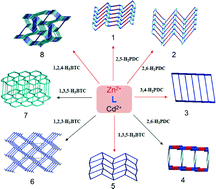Eight new Zn(II) and Cd(II) coordination networks containing N,N′-di(3-pyridyl)adipoamide (L) and polycarboxylate ligands, {[Zn2(2,5-PDC)2(L)(H2O)2]·2H2O}∞ (H2PDC = 2,5-pyridinedicarboxylic acid), 1, [Zn2(2,6-PDC)2(L)]∞, 2, {[Zn2(3,4-PDC)2(L)(H2O)6]·4H2O}∞, 3, {[Cd(2,6-PDC)(L)(H2O)]·4H2O}∞, 4, [Zn(1,3,5-HBTC)()]∞ (H3BTC = benzenetricarboxylic acid), 5, {[Cd(1,2,3-HBTC)(L)(H2O)]·H2O}∞, 6, {[Cd2(1,3,5-HBTC)2(L)(H2O)2]·2H2O}∞, 7, and {[Zn3(1,2,4-BTC)2(L)(H2O)4]·4H2O}∞, 8, have been synthesized by hydrothermal reactions and characterized by single crystal X-ray crystallography. Structural analysis reveals that 1 and 2 form pleated hcb layers with 1D helical chains, in which the layers of 1 interdigitate with each other and those of 2 are linked by the π–π stacking interactions. Complexes 3 and 4 exhibit 1D ladders with single and double rungs, respectively, whereas 5 shows a 2D pleated net with the sql topology, 6 displays a 3D dia coordination network and 7 forms a 2D structure with the (63)(66)-3,4L88 topology. The BTC3− ligands in 8 adopt the μ4-bonding modes, resulting in a 3D coordination network with the rare (65·8)-hxg-d-4-P2/c topology. The various bonding modes, the ligand-isomerism of the polycarboxylate ligands and the identity of the metal center play important roles in determining the structural diversity. Their thermal and luminescent properties are also discussed.

